Editor's note: Terry Grapentine is principal of Grapentine Company LLC, an Ankeny, Iowa, research firm. The author wishes to thank the following for offering valuable comments on earlier drafts of this article: Chuck Chakrapani, president, Leger Analytics and distinguished visiting professor, Ted Rogers School of Management; Brian Kiley, market research analyst, West Bend Mutual Insurance Company; David S. Grapentine; and David Soorholtz, MarketSense Inc.
Marketing researchers create various kinds of constructs such as “perceived product quality” and “brand loyalty.” How well one defines such constructs and how validly one measures them affects both the overall quality of the research and the success of the decisions based on that research. In this light, the purpose of this article is to 1) increase your understanding of what constructs are; 2) explain why developing good constructs is critical to conducting quality marketing research; and 3) provide you a few practical tools for developing better constructs in future studies.
Two quick comments for clarification: First, the topic of what constructs are is rather complicated and cannot be comprehensively covered in this article. Consequently, this piece focuses on the kind of constructs used in brand image studies to predict brand loyalty. There are other kinds of marketing constructs – such as “convenience goods” or “light, moderate, and heavy buyers” – that describe different kinds of products or consumers. For a discussion of those kinds of constructs see the Goertz reference at the end of this article.1
Second, concepts are similar to constructs. When a concept is created or used for special scientific purposes, concepts are called constructs.2 Thus, we often refer to product quality, satisfaction and similar marketing concepts as constructs when we use them in our research activities.
What is a concept/construct?
Have you ever stopped to ask yourself, “What is a concept/construct?”
Real-world example: Consider the concept of “chair.” I use the term “concept” instead of “construct” because this example is not based on using the concept of chair in a scientific investigation; however, the example will help you understand how concepts and constructs are similar.
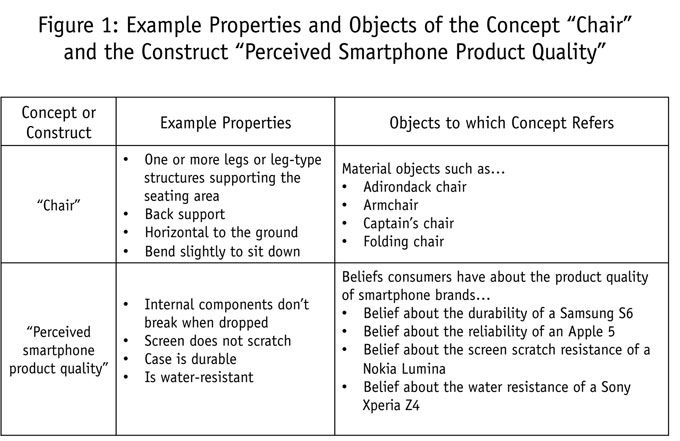
There are many kinds of chairs. To facilitate communication, we use the term “chair” to designate a concept that refers to objects sharing certain properties. An example – not an exhaustive list – of properties that all chairs share are the following: 1) has a leg or leg-type structures supporting the surface on which one sits; 2) provides some level of back support; 3) sits horizontally to the ground; and 4) the seating surface is at such a level that adults must bend slightly at the waist in order to sit on the seating surface. Concepts and constructs group objects that share the same properties, as depicted for the chair concept in Figure 1.
Marketing research example: Just as the concept of “chair” possesses certain properties, the construct of “perceived smartphone product quality” possesses certain properties (Figure 1). Analogously, just as the concept of chair refers to certain objects, the construct of perceived smartphone quality refers to certain non-material objects: beliefs that consumers have about smartphone brands. Thus, objects to which concepts or constructs refer may be material or non-material.
Definition of concept/construct: With Figure 1 in mind, consider the following definition of a concept/construct: a generalized abstraction of some aspect of reality that we want to understand for the purposes of communicating to others (e.g., “Please sit in that chair.”) or doing research (e.g., “How does perceived product quality influence brand choice?”).3 Now, let’s unpack this definition and discuss what the terms “generalized” and “abstraction” mean.
A concept/construct is generalized because it applies to all objects that possess a concept’s/construct’s properties. In Figure 1, the concept of chair refers to many different kinds of objects that possess the listed properties. The construct of perceived product quality of smartphones refers to certain beliefs consumers possess about various smartphone brands.
A concept/construct is an abstraction because it refers to a group of objects that share certain properties. Adirondack chairs, armchairs and captain’s chairs possess the properties of the chair concept. Beliefs about smartphone brands’ product quality possess the properties of the perceived smartphone product quality construct.
As a side note, examples of mental states around which we can form constructs are beliefs about products, intentions toward purchasing particular brands, feelings toward brands (e.g., positive vs. negative) and values influencing purchasing decisions (e.g., “I only purchase ‘green’ products”).
Within the realm of thought
Where do marketing research constructs originate? Researchers construct them when they think about solving marketing problems. Constructs, therefore, originate within the realm of thought.4
Generally, exploratory research – traditionally in the form of focus groups or one-on-one interviews – is the field from which constructs are harvested. Currently, the marketing research field is brimming with many new exploratory research techniques and methods – such as consumer blogs, virtual consumer communities and biometric responses to product concept tests or advertising – to help uncover new marketing constructs. What’s more, researchers are borrowing constructs from other fields such as behavioral economics (e.g., confirmation bias, decision heuristics and anchoring effects) to better understand consumer purchasing behavior.
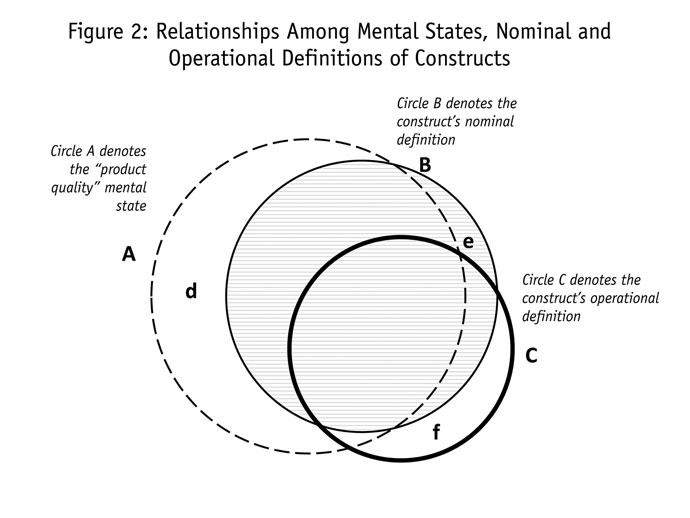
Constructs, therefore, are the fundamental building blocks of science in general and marketing research in particular. They help us conceptualize what influences consumer behavior; design marketing research studies to measure those influencers; and provide a platform on which to construct theories that help us explain, understand, predict and, to some degree, influence markets.
This article uses the idea of perceived smartphone product quality to explain how mental states, nominal and operational definitions of constructs relate to each other (see Figure 2).
Researchers assume that “something like” a product quality construct exists as a hypothetical mental state in consumers’ minds. I say “something like” because this construct refers to an aspect of consciousness that does not have objective reality like, say, a cup of coffee does. Circle A denotes the information that is contained in that mental state – i.e., beliefs about smartphone product quality – under conditions of perfect knowledge.
Circle B represents the construct’s nominal definition. A nominal definition is the meaning of a term using other terms, like a dictionary definition. For example, the nominal definition of the construct “product quality of smartphones” might be the following: consumer beliefs about how durable and long-lasting the physical components of a smartphone are. Relevant properties of the product quality construct (as given in Figure 1) should also be listed as part of this definition.
Circles A and B do not perfectly overlap because researchers do not possess perfect knowledge of Circle A. For example, letter d denotes information in Circle A that is not captured by the nominal definition in Circle B.
In some situations, the researcher’s nominal definition may contain information about Circle A that is incorrect, denoted by the letter e. For example, a researcher may have included information about a smartphone’s ergonomic design in the nominal definition of product quality (e.g., “easy to see display in sunlight”); whereas, ergonomics is more properly construed as a construct separate from product quality.
Circle C denotes the construct’s operational definition. The operational definition of a construct describes how a construct is to be measured. For instance, constructs such as product quality are often measured by having respondents rate one or more brands on an attribute list.
Measurement error is introduced into these operational definitions if they measure properties not part of Circle A – denoted by f – or if they exclude properties in Circle A, denoted by d. Area f, for instance, might be an attribute measuring the perceived weight of a smartphone, which is not part of Circles A or B. For example, “weight” may be part of an “ease of handling” construct.
How does one ever know how much overlap there is among Circles A, B and C, and whether something like Circle A even exists in consumers’ minds?
I discuss this topic in the following three-step process of creating and examining marketing constructs: 1) nominal definition meaningfulness; 2) operational definitions; and 3) operational definition validity. All three steps help the researcher address the idea of construct validity. In its simplest conceptualization, construct validity is the extent to which a construct measure (Circle C) accurately measures the construct it is intended to measure (Circle A).
Step 1: Examining nominal definition meaningfulness5
The first step in examining the potential usefulness of a construct is to assess how meaningful the construct is. A construct is meaningful to the extent that it helps a researcher explain, understand, predict and ultimately influence some aspect of consumer behavior such as, “Why do consumers purchase our competitors’ products and not ours?” This examination is made after conducting the exploratory research but before launching the quantitative study. Suggested steps to follow are discussed below.
Identify the constructs. Identify the general constructs that you feel are important to your study. For discussion purposes, assume we are interested in examining factors associated with affecting smartphone brand choice among a target group of consumers. Simply list these constructs with their nominal definitions.
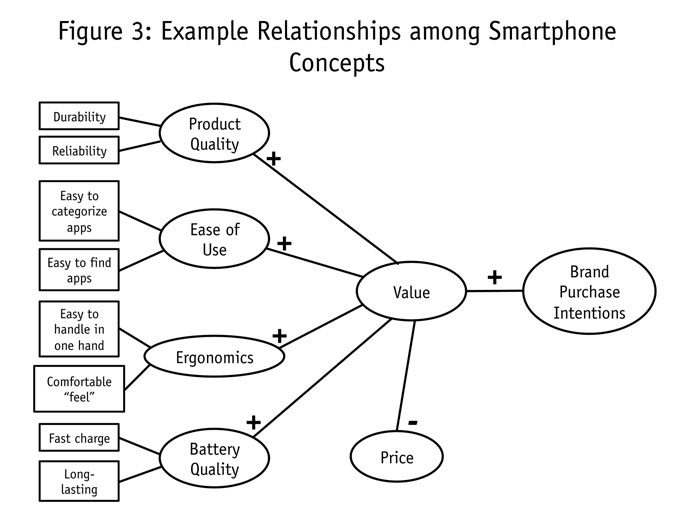
Show how these constructs relate to each other within a theoretical framework. This can take the form of a molecule diagram model as shown in Figure 3. The rectangles denote measures (i.e., the attribute ratings) of each construct (e.g., product quality) that predicts value. The symbols + and - denote whether the relationship between the constructs is positive or negative. For example, as perceptions of product quality improve, all else held constant, perceived value improves. For purposes of economy, rectangles denoting the measures of price, value and brand purchase intentions are not given.
Critique each construct in the model. Do this with other researchers or people who are knowledgeable of the exploratory research or have significant background knowledge of the marketing category under investigation. Example questions to ask for each construct are as follows:
- What basic idea does this construct capture and is it meaningful? Examine a construct’s nominal definition. Does the language being used to define the construct capture its intended meaning?
- Do the construct’s listed properties reflect that construct and not some other construct? As discussed earlier, the attribute “easy to see display in sunlight” may not be congruent with the idea of product quality. It may be an indicator of another construct such as “ease of use.”
- Are all the construct’s relevant properties listed? Review the exploratory research findings in answering this question. Note: The universe of all properties of a concept is called the concept’s domain. The number of such properties is beyond what a single marketing research study can examine. Therefore, the researcher’s goal is to identify a representative sampling of properties that adequately reflect the concept’s domain.6
- Have any constructs been omitted? For example, has Figure 3 left out any constructs that influence brand purchase intentions? Perhaps a construct needs to be added that captures the performance of certain features of a phone that affect brand choice, such as attributes descriptive of the phone’s camera.
- Are the constructs distinctive? For instance, is ease of use different from ergonomics? Brainstorm with colleagues about whether a) some of the constructs should be combined into one; or b) a given construct should be divided into one or more constructs.
- Are the relationships among the constructs specified correctly? Perhaps battery quality should be linked directly with product quality as opposed to being separate from product quality.
- Is this the best name to give this construct? The construct’s name eventually appears in reports to management and you want to insure it communicates effectively what you want to communicate. For example, “product caliber” is awkward language to communicate the idea of product quality.
Items 1 through 5 relate to the notion of content validity. Content validity (sometimes called face validity) examines how well the scale items used to measure a construct represent the concept’s domain. For example, in Figure 1, “perceived smartphone product quality” captures four different aspects of quality. Are there more? For instance, one might argue that the following property is part of the quality construct: “The phone’s screen is resistant to breaking.”
Researchers don’t have the time or resources to create the perfect questionnaire. For example, you can’t measure all properties of all constructs that affect consumer brand choice. Use the collective knowledge of the brand team to winnow down the list of constructs to the most critical
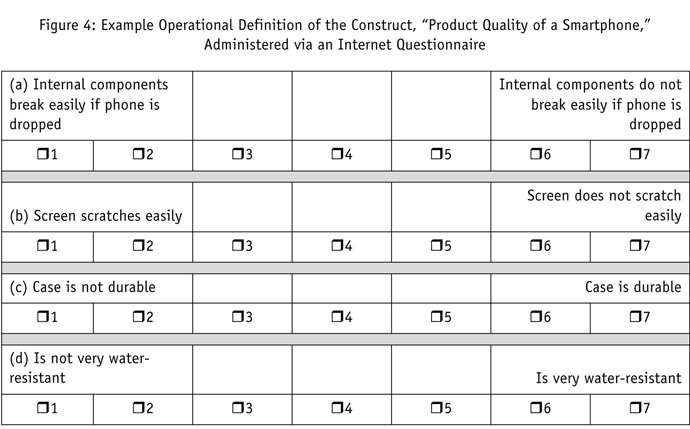
Step 2: Examining the operational definition
A construct’s operational definition is a description of how a construct is to be measured and it focuses on all aspects of construct measurement, such as using an Internet survey vs. a telephone interview; question order; survey appearance and even the instructions given respondents. See Figure 4 as an example of an operational definition of smartphone product quality. In examining the goodness of a construct’s operational definition, I recommend the following:
Each of the construct’s properties should be measured with at least one attribute. In Figure 4, the property of “won’t break” is measured by (a) and (c). The properties of “screen scratch resistance” and “water resistance” are measured with single attributes. To improve this construct’s validity, one might consider additional attributes. For instance, attribute (d) might be replaced with two attributes, e.g., “Not resistant/very resistant to water when submerged” and “Not very resistant/very resistant to water when splashed on.”
Test the attributes with target respondents. Respondents should interpret the attributes on a questionnaire in the manner in which the researcher intends for them to be interpreted. Therefore, attributes should be unambiguous, understandable and not “double-barreled.”
Step 3: Operational definition validity and reliability
This phase of construct development and refinement assumes that the constructs being used in the study have passed a rigorous examination of their nominal definition meaningfulness and operational definitions.
Note the following: Step 3 involves statistical analysis of the data generated in your quantitative study. This can be disheartening because some of the analyses used to examine the validity of your construct measures are done after you collected the data. If you discover that an attribute does not pass muster in Step 3, you should omit it from your analysis.
Typically, analysis of construct validity assumes that you are using a summated scale to measure a construct. A summated scale is created, at the respondent level, by taking the average of the items comprising the construct. For example, if a given respondent rated each of the four attributes in Figure 4 as follows: (a) = 6; (b) = 7; (c) = 5; and (d) = 6, the summated scale rating for this construct, for this respondent, is 6.0.
The remaining discussion covers the following operational definition validation methods: construct validity; convergent validity; discriminant validity; coefficient alpha; and predictive validity.
One aspect of construct validity “focuses on the assessment of whether a particular measure relates to other measures consistent with theoretically derived hypotheses concerning the … constructs … that are being measured.”7 Figure 3 is an example of a theoretical framework in which one aspect of construct validity can be examined. (Note: There are other aspects of construct validity that are less applicable to the average marketing researcher. The interested reader can find them in any college-level marketing research text book.)
For example, in many marketing surveys, you expect measures of value to be positively correlated with other constructs theoretically linked to it such as product quality, ergonomics and ease of use. Thus, in your surveys, examine correlations between constructs that are theoretically linked. The correlation coefficients should be statistically significant and carry the right “sign,” (i.e., the correlation coefficient should be positive if the theoretical relationship is positive; negative, if the relationship is negative).
Construct validity also encompasses two other construct validation methods: convergent and discriminant validity.
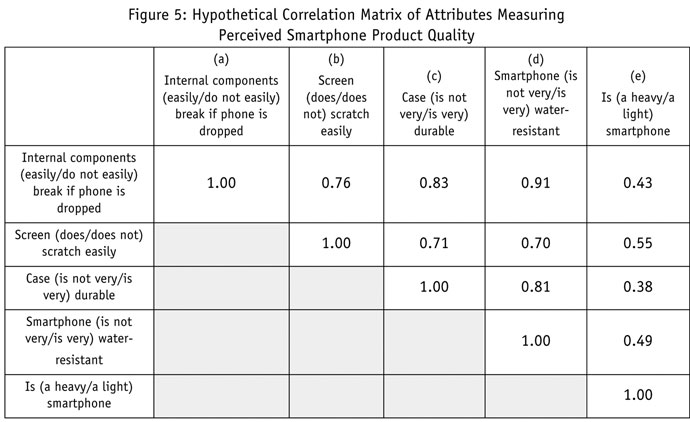
Convergent validity “is the extent to which the scale correlates positively with other measures of the same construct.”8 For example, the four attributes in Figure 4 should be significantly correlated with each other if, indeed, they are good indicators of a smartphone’s product quality. You can examine this by creating a correlation matrix of the relevant attribute measures. Figure 5 gives an example. Although there is no objective standard as to what constitutes a “significant” correlation, generally, correlations near or greater than 0.7 are mentioned in the literature; however a literature search reveals that these standards can vary by field (e.g., psychology vs. sociology vs. marketing). In Figure 5, correlations between attributes a, b, c and d meet this criterion; attribute e does not.
Discriminant validity is the extent to which a measure does “not correlate too highly with measures from which it is supposed to differ.”9 For example, attributes that measure, say, the ease of use construct in Figure 3 should not be highly correlated with the attributes used to measure the ergonomics construct.
Cronbach’s coefficient alpha is a summary measure of the intercorrelations of a set of items used to measure a construct. Its value ranges from 0.0 to 1.0, where larger alphas indicated higher intercorrelations. As a rule of thumb, alphas of 0.7 or higher are desirable.
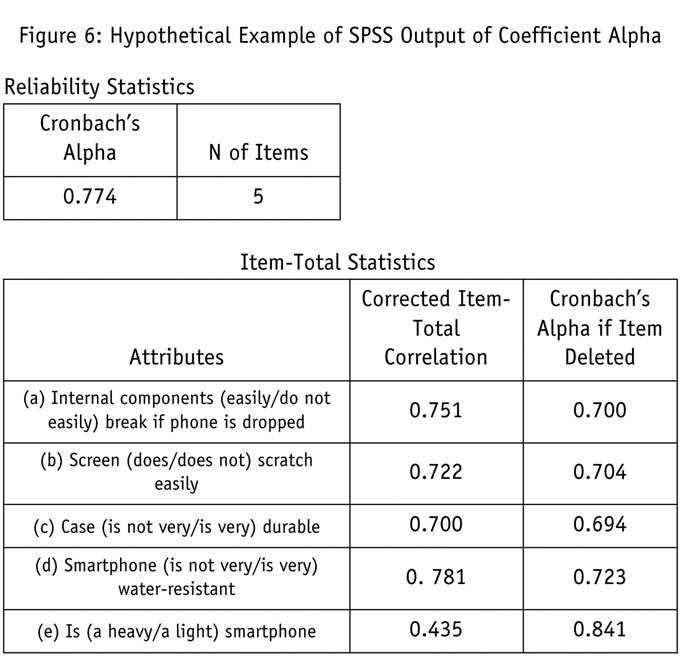
A hypothetical example of SPSS output of coefficient alpha is given in Figure 6. “Reliability Statistics” shows an alpha of 0.774, based on five attributes, a through e. “Item-Total Statistics” provides the following information:
- The list of attributes included in the analysis.
- “Corrected Item-Total Correlation” is the correlation of a given item with a summated scale of the remaining items. For example, the correlation of item a with a summated scale comprised of items b through e is 0.751.
- Coefficients of 0.7 or higher are desirable. This statistic for item e, 0.435, therefore raises a red flag.
- “Cronbach’s Alpha if Item Deleted” is the alpha statistic for a given attribute when it is deleted from the construct measure. For example, if item e is deleted, alpha increases from 0.774 to 0.841. This indicates that the four other attributes as a group are a more reliable measure of the construct than if item e were added to the analysis.
Coefficient alpha is a measure of reliability, not validity. Reliability refers to the repeatability of a measure. Are you likely to obtain the same results if you repeat the survey? In contrast, validity is concerned with whether a construct is measuring what it is intended to measure. Thus the old saw: All valid measures are reliable but not all reliable measures are valid.
Predictive validity is what the name implies: How well can a measure collected at one point in time predict a criterion measure collected at a future point in time? Examples are: How well does a new product concept test predict future purchase levels of a new product? How well does a study that measures future brand purchase intentions predict actual future brand purchases? How well does an employee satisfaction survey predict employee retention over time?
At least in my experience, most organizations do not conduct controlled experiments that examine the predictive power of their constructs; it’s too time-consuming and cost-prohibitive.
Consequently, we’re left with the question raised earlier. How do we know that “something like” our constructs represented in Figure 2 really exist and that our nominal and operational definitions of them overlap relatively closely? We can never know for certain but by following the three-step process outlined in this article, you will increase the likelihood that you have developed more valid constructs than you would have otherwise.
After all, creating more valid constructs is the first step leading toward making more successful decisions.
REFERENCES
1 For more information on these kinds of concepts, see Goertz, Gary (2006), Social Science Concepts: A Users Guide. Princeton University Press, Princeton, N.J.
2 Kerlinger, Fred N., and Howard B. Lee (2000), Foundations of Behavioral Research. Harcourt College Publishers, New York, page 4.
3 Jaccard, James and Jacob Jacoby (2010), Theory Construction and Model Building. The Guilford Press, New York, page 11.
4 Zaltman, Gerald and Christian R.A. Pinson, and Reinhard Angelmar (1973), Metatheory and Consumer Research. Holt, Rinehart and Winston, New York, p. 22.
5 This section of the paper is inspired by Zaltman et als., book in reference 3 and the following article: Teas, Kenneth R., and Kay M. Palan (1977), “The realms of scientific meaning framework for constructing theoretically meaningful nominal definitions of marketing concepts.” Journal of Marketing, April, pages 52-67.
6 Churchill Jr., Gilbert A., (2001), Basic Marketing Research. The Dryden Press, New York, p. 370-371.
7 Zeller, Richard A., and Edward G. Carmines (1980), Measurement in The Social Sciences. Cambridge University Press, London, p. 81.
8 Malhotra, Naresh K., (2010), Marketing Research: An Applied Orientation, 6th Ed. Prentice Hall, New York, p. 289.
9 Malhotra, (2010), p. 289.
